ISSN ONLINE(2278-8875) PRINT (2320-3765)
ISSN ONLINE(2278-8875) PRINT (2320-3765)
C.Bhargava1, P.S.R Murty2, K.Rajender3
|
| Related article at Pubmed, Scholar Google |
Visit for more related articles at International Journal of Advanced Research in Electrical, Electronics and Instrumentation Engineering
This paper presents basic reliability evaluation techniques needed to evaluate the reliability of distribution systems which are applied in distribution system planning and operation. In this paper we consider seven different alternatives and examined on distribution system. Basically the reliability study can also help to predict the reliability performance of the system after quantifying the impact of adding new components to the system. The number and locations of new components needed to improve the reliability indices to certain limits can be identified and studied. In this paper introduced partial automation this automation has proven to be a feasible and efficient alternative in these studies.
Keywords |
| Distribution system, Reliability evaluation, Partial automation, Customer interruption costs. |
INTRODUCTION |
| The basic function of an electrical power system is to meet its customers while maintaining acceptable levels of quality and continuity of supply [1]. In this context, the term reliability has a broad, general meaning. It includes load or demand side measures such as quality and continuity of service as understood by the customer. Since the primary purpose of the system is to satisfy customer requirements and since the proper functioning and longevity of the system are essential requisites for continued satisfaction, it is necessary that both demand and supply side considerations are appropriately included. It is important to note that the distribution system is a vital link between the bulk power system and its customers. In many cases, these links are radial in nature that makes them vulnerable to customer interruptions due to a single outage event. A radial distribution circuit generally uses main feeders and lateral distributors to supply customer energy requirements. In the past, the distribution segment of a power system received considerably less attention in terms of reliability planning compared to generation and transmission segments. The basic reason behind this is the fact that generation and transmission segments are very capital intensive, and outages in these segments can cause widespread catastrophic economic consequences for society. An electric power system comprises generation, transmission and distribution. It is also necessary to ensure a reasonable balance in the reliability of these various constituent parts [2]. Electric power distribution systems constitute the greatest risk to the interruption of power supply. It has been reported in the literature that more than 80% of all customer interruptions occur due to failures in the distribution system. The distribution segment has been the weakest link between the source of supply and the customer load points. Though a single distribution system reinforcement scheme is relatively inexpensive compared to a generation or a transmission improvement scheme, an electric utility normally spends a large sum of capital and maintenance budget collectively on a huge number of distribution improvement projects. Distribution utilities are required only to furnish historical distribution system performance indices to regulatory agencies. Reliability evaluation and maintenance planning techniques have separately been well developed. |
| A great problem encountered in the area of distribution systems is how to reduce the number of interruptions experienced by customers. At first, these reductions can be obtained with the substitution of the equipment with the high failure rates and by increasing the maintenance staff. Usually, these are very expensive solutions. The automation of the protection has proven to be a feasible and efficient alternative to solve this problem [4]. A reliability evaluation can be used to evaluate past performance and predict future performance of the distribution system. A reliability evaluation study can also identify the problematic components in the system that can impact reliability. The reliability study can also help to predict the reliability performance of the system after any expansion and quantify the impact of adding new components to the system. The number and locations of new components needed to improve the reliability indices to certain limits can be identified and studied. Distribution system protection and restoration along with loss reduction are some of the most important topics concerning contemporary power engineering research. Two main parameters lead power utilities nowadays to redefine their policies regarding investments on power networks. The first parameter is the demand for increased reliability considering the fact that the way of living today (both at personal and professional level) tends to become fully dependent on electricity. On the other hand the energy problem and its consequences to the environmental pollution render the need for energy saving more imperative than ever. Considerable research has been accomplished so far for systems and methods that contribute in loss reduction across distribution networks and reliability improvement. |
| Customer satisfaction regarding reliable electric supply is becoming increasingly important in the new deregulated electric utility environment. Customer outage costs due to electric supply failures are of concern to both utilities and customers. Customer outage cost assessments have been conducted in many countries and the results applied using both analytical and simulation techniques to assess reliability worth. The magnitude of the interruption cost associated with a specific delivery point will depend on many factors. These include the load curtailed, the type of customers involved and the duration of the outage. The time of day, day of the week and time of year will also have an influence on the magnitude of the interruption cost. In order to make the estimation of delivery point interruption costs a reasonable task, there is obviously a need to develop approximate techniques that use a minimum of load point topology and customer demographic data and still provide acceptable interruption cost estimates. The object of this paper is to present the basic reliability evaluation techniques needed to evaluate the reliability of distribution systems needed to evaluate the reliability of distribution systems. |
RBTS DISTRIBUTION SYSTEM ANALYSIS |
| Example system shown in Figure 1 is used to illustrate the proposed arrangements. Detailed reliability data associated with this system are presented in [5]. |
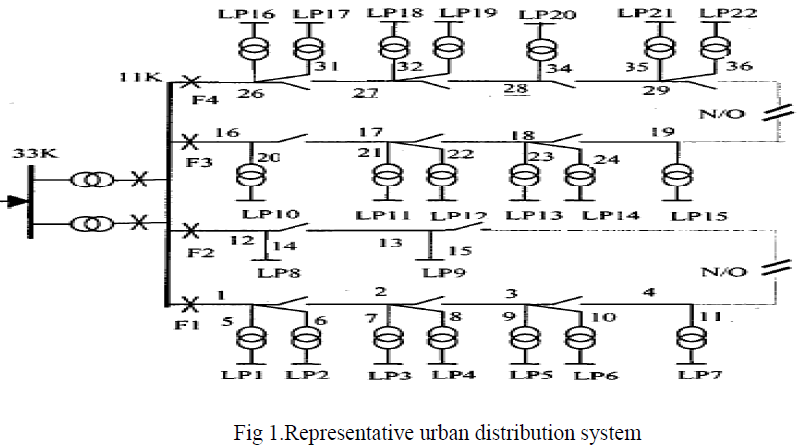 |
RELIABILITY INDICES |
| A distribution system is the segment of an overall power system which links the bulk system to the individual customers. The basic distribution system reliability indices are the three load point indices of average failure rate, the average outage duration r and the annual outage duration U. These three basic indices are important individual load point parameters. The system indices of SAIFI, SAIDI, CAIDI, ASAI and ASUI can be calculated from the three basic load point indices. The reliability cost worth indices of expected energy not supplied (EENS), expected interruption cost (ECOST) and interrupted energy assessment rate (IEAR) can also be calculated using the three basic load point indices. For the reliability evaluation and improvement of reliability indices for radial distribution system of feeders we consider seven different possible alternatives listed below and the same were applied to a typical RBTS urban distribution system. The seven different alternatives considered are as follow. |
| 1) Base case |
| 2) Effect of lateral distributor protection |
| 3) Effect of disconnects |
| 4) Effect of protection failures |
| 5) Effect of transferring loads without restrictions on transfer |
| 6) Effect of transferring loads with restrictions on transfer |
| 7) Partial Automation |
1) Base Case: |
| In this case no fuse gears, disconnects on the feeder |
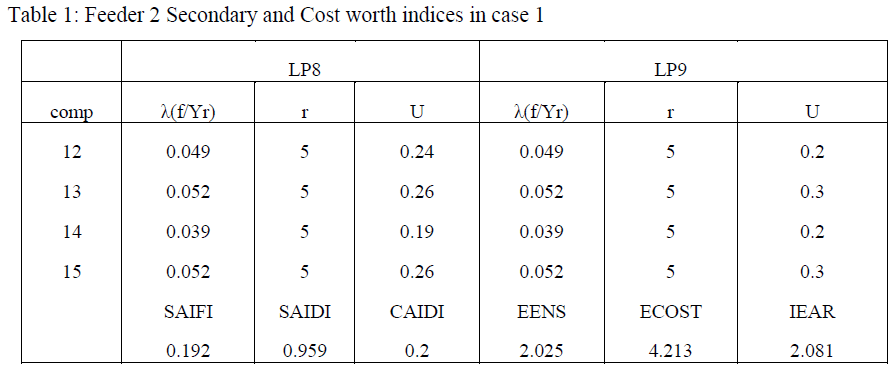 |
2) Effect of lateral distributor protection: |
| In this arrangement of protection of lateral distributor to install fuse gear at the tee- point in each lateral distributor. In this case a short circuit on a lateral distributor causes its appropriate fuse to blow; this causes disconnection of its load point until the failure is repaired but does not affect or cause the disconnection of any other load point. |
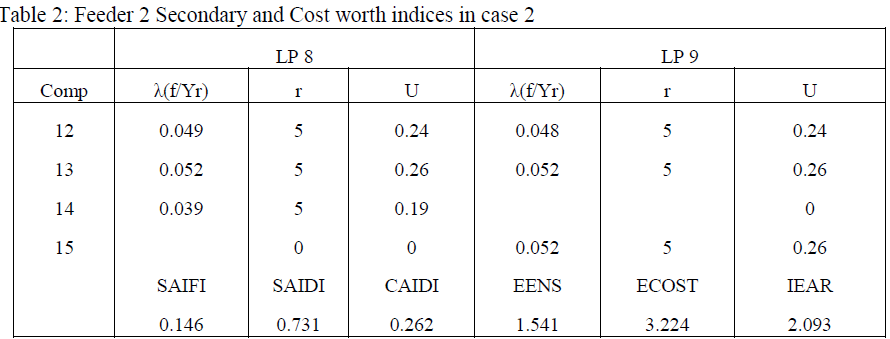 |
3) Effect of disconnects |
| In this arrangement the provision of disconnects or isolators at appropriate points along the main feeder. These are generally not fault-breaking switches and therefore any short circuit on a feeder still causes the main breaker to operate. After the fault has been detected, however, the relevant disconnect can be opened and the breaker reclosed. This procedure allows restoration of all load points between the supply point and the point of isolation before the repair process has been completed. |
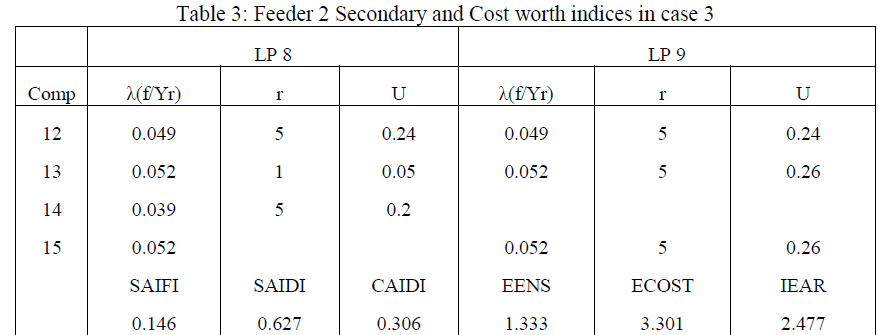 |
4) Effect of protection failures |
| In this arrangement fuses in the lateral distributor operated whenever a failure occurred on the distributor they were supposed to protect. In which assume that the fuse gear operates with a probability of 0.9, i.e. the fuses operate successfully 9 times out of 10 when required. The contribution to the failure rate can be evaluated using the concept of expectation |
| Failure rate = (failure rate | fuse operates) x p (fuse operates) + (failure rate | fuse fails) x P (fuse fails) |
| Table 4: Feeder 2 Secondary and Cost worth indices in case 4 |
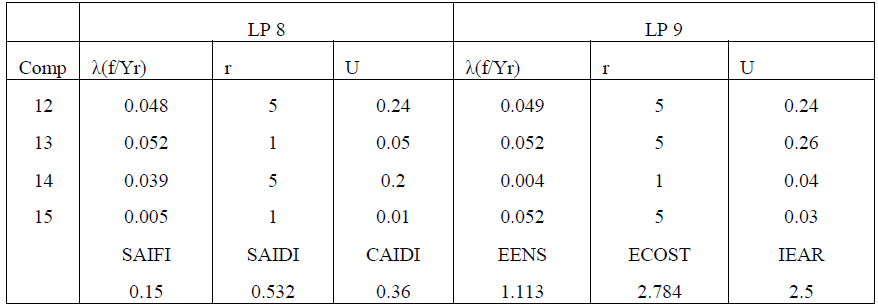 |
5) Effect of transferring loads without restrictions on transfer |
| In this case, assuming that there is no restriction on the amount of load that can be transferred through the back feed. In which the failure rate of each load point does not change, that the indices of load points do not change because load transfer cannot recover any load lost, and that the greatest effect occurs for the load point furthest from the supply point and nearest to the normally open transfer point. |
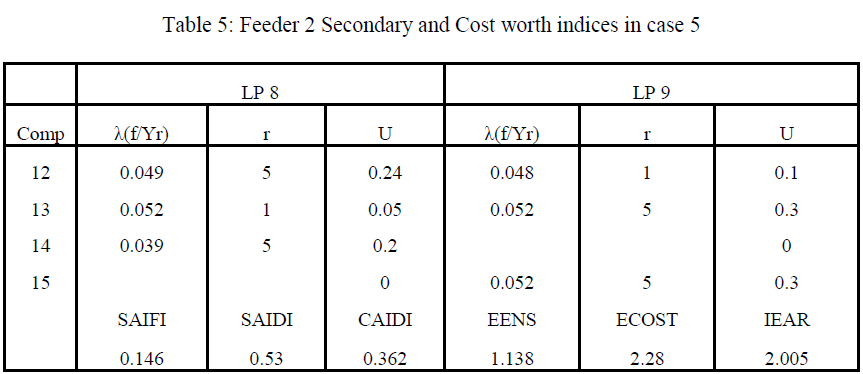 |
6) Effect of transferring loads with restrictions on transfer |
| In this case the outage time associated with a failure event is equal to the isolation time if the load can be transferred, or equal to the repair time if the load cannot be transferred. The average of these values can be evaluated using the concept of expectation. |
| Outage time = (outage time | transfer) x P (of transfer) + (outage time no transfer) x P (of no transfer) |
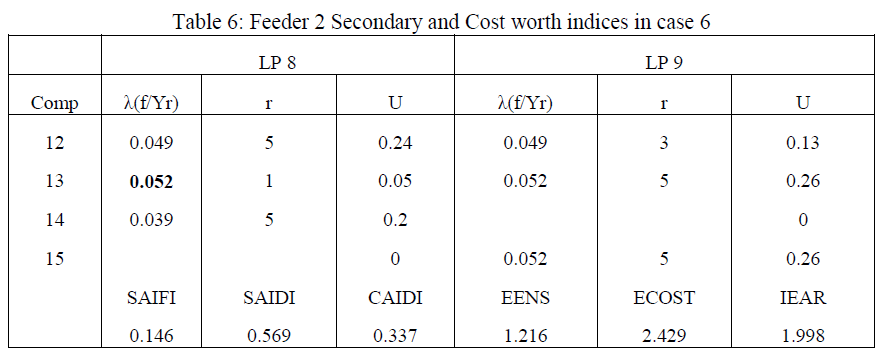 |
7) Automation applied to the feeder |
| In this arrangement we consider automation. In automation process the first switch on feeder 2 considers automation and remaining manual. |
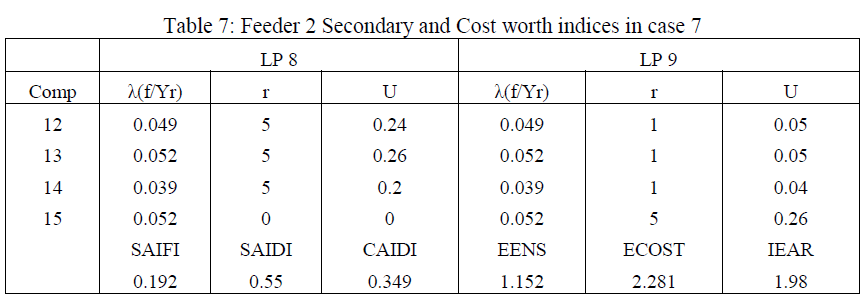 |
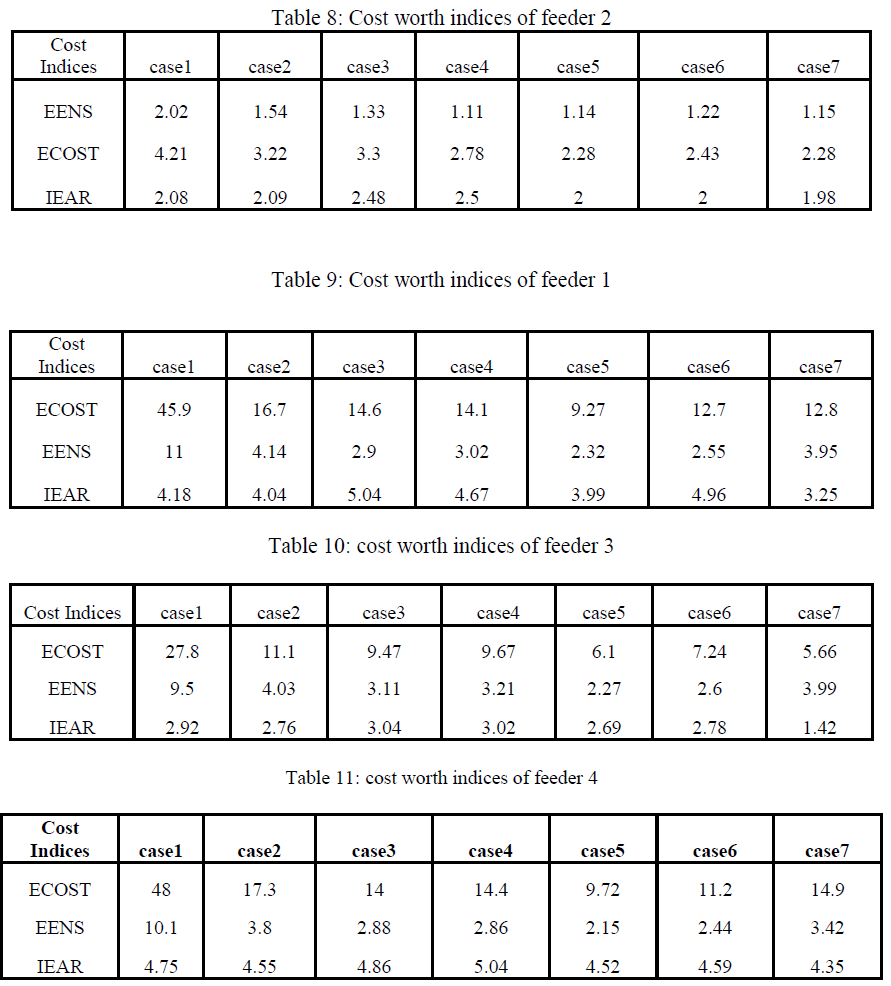 |
| A summary of all the indices evaluated in tables 1to 8 is shown in below illustrated Figures. |
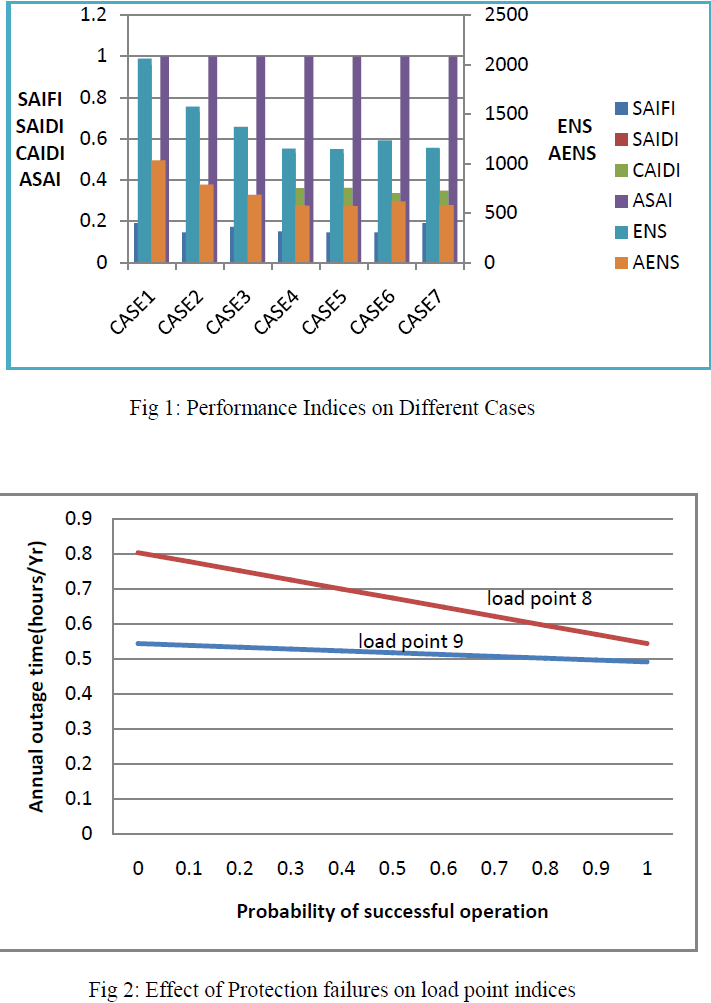 |
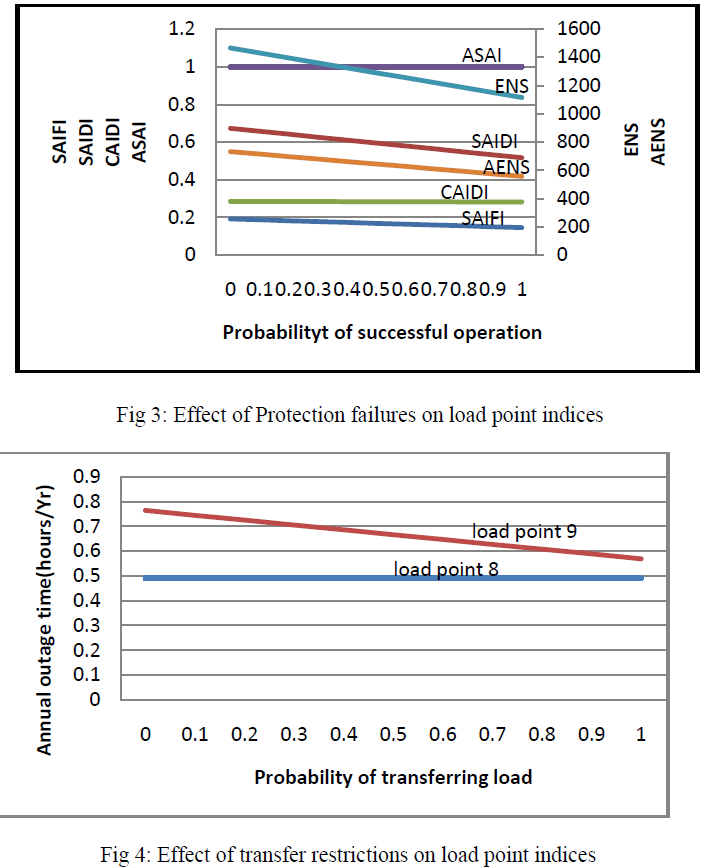 |
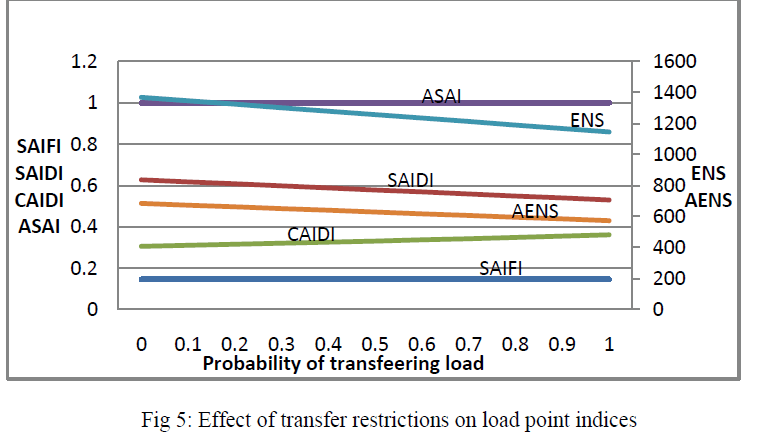 |
CONCLUSION |
| This paper has shown different techniques for improving the reliability in radial distribution system. In this paper above mentioned all techniques examined on considering system and finally calculated cost/worth indices values. These values decreases with increasing the investment on radial distribution system..In this paper introduced seven cases for the assessment of reliability of urban distribution system and relationship between characteristics and policy has been shown using case studies The partial automation shows major affect on the improving the reliability of selected distribution system |
References |
|